Top 10 Famous Jaisalmer Tourist Places
Jaisalmer Tourist Places: Are you ready to join us on a captivating journey to the heart of Rajasthan, where history, culture, and natural beauty converge in a mesmerizing tapestry? Welcome to our comprehensive guide to the enchanting Jaisalmer tourist places. In this blog post, we will take you on a virtual tour through the renowned Jaisalmer Tourist Places, ensuring you don’t miss a moment of the city’s rich heritage and vibrant atmosphere. Join us as we wander through the ancient streets, discover the architectural marvels, and immerse ourselves in the unique charm of Jaisalmer tourist places. So, let’s set forth and unearth the hidden gems that make Jaisalmer Tourist Places a destination like no other.
Table of Contents
Top 10 Jaisalmer Tourist Places
1- Jaisalmer Fort

Jaisalmer Fort stands as the largest and one of the most expansive forts in the world. Situated atop Tirukuta Hill, this architectural marvel was commissioned by Rao Jaisal, a formidable ruler of Jaisalmer. Due to its location amidst the golden expanse of the Thar Desert, it is affectionately known as the ‘Sonar Quila’ or the ‘Golden Fort.’ Over centuries, it has witnessed countless battles and retained its pride as one of Rajasthan’s most splendid forts. Despite the fading echoes of kings and battles, their timeless legacy lives on within these fortifications. Inside the fort, you’ll discover an array of captivating monuments, including the Raj Mahal, Laxminath Shrine, Merchant Havelis, ornate Jain temples, and grand gateways. The 250-foot-high sandstone walls, soaring 30 feet above the ground, radiate a golden hue, which earned it the moniker ‘Golden Fort.’ The main entrance, elevated to around sixty feet, is crafted from the finest rosewood. The fort’s interior reveals stables and fortresses that once housed the proud Rajputana kings.
2- Sam Sand Dunes

Sam Sand Dunes offers an authentic desert experience and is a must-visit attraction in Jaisalmer. These dunes, towering between 30 and 60 meters in height, are perfect for thrilling desert safaris on camels or jeeps. Sam is located 45 kilometers west of Jaisalmer City and can be easily reached by hiring a vehicle. You can opt to stay in one of the desert camps, typically situated within a 2 to 3-km radius of the dunes. The best times to visit Sam Sand Dunes are in the evening to witness the desert sunset between 4 and 7 PM or early in the morning during the 4 to 6 am sunrise. You can book camel or jeep rides in advance or on-site at the desert camps. The ideal time to visit Sam and Jaisalmer is from October to March, when the camps are operational, as many close during the remaining months. Additionally, the evening musical programs at Sam’s desert camps are unavailable during the summer and monsoon seasons.
3- Gadsisar Lake
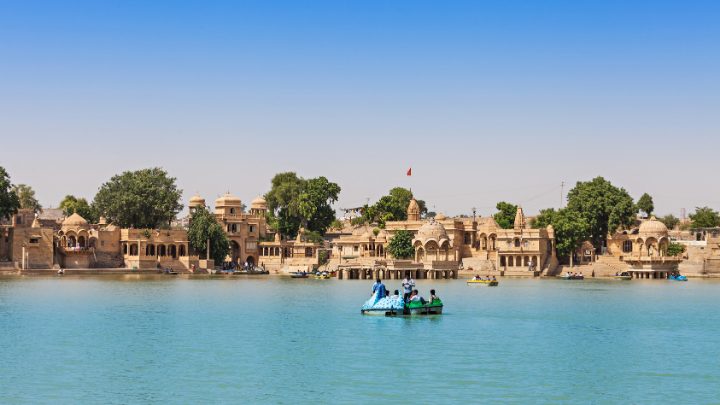
Constructed in 1400 AD by Maharwal Gadsi Singh, the then Maharaja of Jaisalmer, Gadsisar Lake was originally built as a rainwater conservation reservoir. It served as a primary water source for the entire city during ancient times. Named after the Maharaja, this lake has become one of the most popular attractions in Jaisalmer, drawing visitors from around the world. Located on the city’s outskirts, it offers an idyllic escape from the bustling urban life, surrounded by numerous temples and shrines. During the winter it becomes a haven for birdwatchers, attracting various exotic and migratory bird species. The shallow ghats, intricately carved cenotaphs, and lush gardens surrounding the reservoir add to its serene beauty, making it a favored picnic spot in Jaisalmer.
4- Patwon Ki Haveli
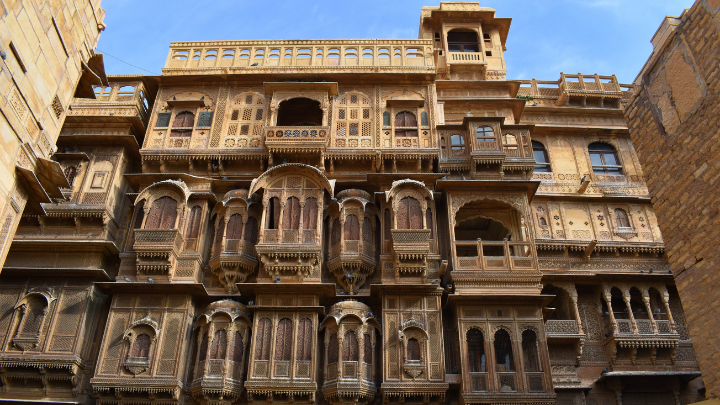
Patwon Ki Haveli is an architectural marvel located in the heart of Jaisalmer. Built in the 19th century, it combines the splendor of five distinct havelis within a single complex. It houses a museum featuring rare artifacts, intricate furniture, miniatures, mirrorwork, and a vast collection of paintings. It was once a hotspot for travelers worldwide. This haveli is historically known as the residence of merchants who traded gold and silver items, some of which were used in ornamental clothing. Today, it houses the office of the Archaeological Survey of India and is considered one of the best places to visit in Jaisalmer.
5- Kuldhara Abandoned Village
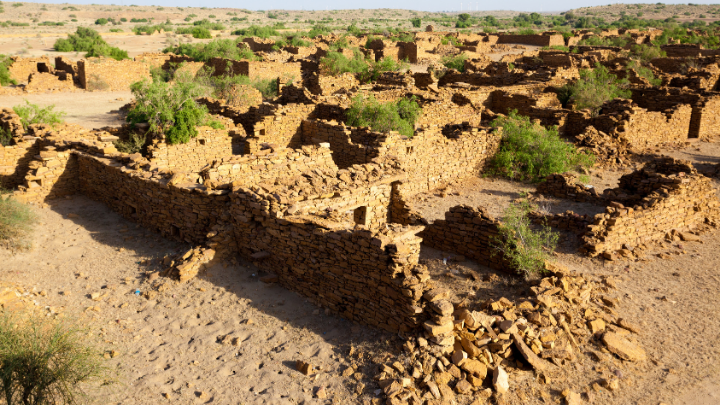
Located 18 kilometers from Jaisalmer, Kuldhara Village, often called the “ghost village,” has remained deserted for centuries. Once inhabited by the Paliwal Brahmins, the villagers mysteriously abandoned the village overnight, leaving no traces of their departure. Legend has it that a curse was placed on the village, foretelling a grim fate for anyone who dared to reside there. The village has become a popular destination for visitors, offering an eerie and captivating glimpse into its enigmatic past. The ideal time to visit Kuldhara is from October to March, when the weather is milder, allowing for a comfortable exploration of the deserted village.
Read This Also: PRS Water Park in Hubli
6- Bada Bagh
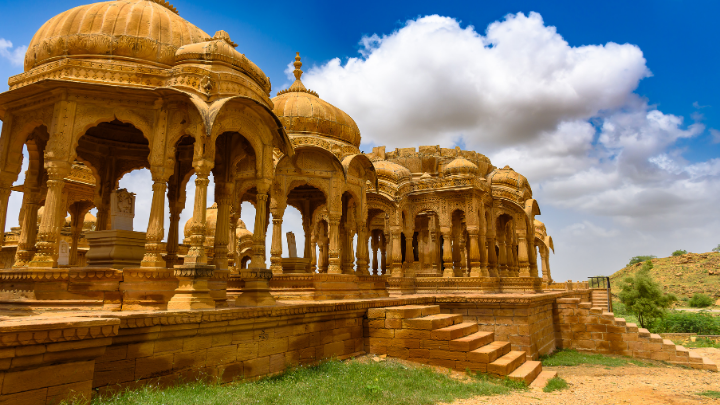
Despite Jaisalmer’s arid surroundings, the rulers endeavored to introduce greenery into the landscape, resulting in Bada Bagh. Located six kilometers from Jaisalmer, this garden complex is home to royal tombs and stands as one of the city’s popular attractions. An artificial dam serves as the main water source for the garden, commissioned by Maharawal Jaisal Singh. While exploring the garden, you’ll come across the Govardhan Stambh, a pillar constructed to commemorate the dam’s completion. The garden also features cenotaphs dedicated to the Bhatti rulers, built in ancient Hindu architecture. Some of these tombstones date back to the earliest days of Jaisalmer’s history, making Bada Bagh one of the best places to visit in the city.
7- Salim Singh ki Haveli
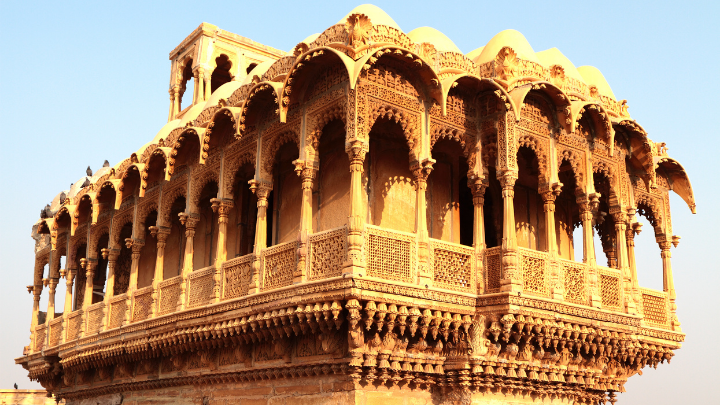
Salim Singh ki Haveli is a prominent tourist attraction in Jaisalmer. This haveli was constructed in the early 18th century on an existing structure and was the residence of the influential Mehta family during that era. Salim Singh, the Prime Minister of Jaisalmer, oversaw the haveli’s construction. It features a unique architectural design, with a roof resembling a peacock’s form, and is situated in the vicinity of Jaisalmer Fort. The haveli’s gateways are flanked by sandstone tuskers, exquisitely carved to perfection, giving the impression of life-like elephants.
8- Jaisalmer War Museum
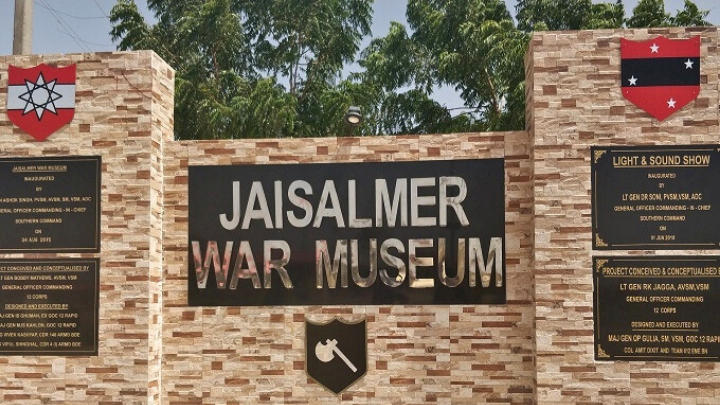
Source: www.museumsofindia.org
The Jaisalmer War Museum is a historical institution established by the Indian Army. It is the first museum of its kind on the Western Front and traces the Indian Army’s evolution, with a particular focus on its significant contributions during the 1965 Indo-Pak War and the 1971 Longewala battle, as well as other combat operations and nation-building endeavors. The museum showcases the valor and courage of the Indian Army’s heroes, featuring exhibits like the 106mm Recoilless Gun used to destroy Pakistani tanks. The museum also includes a state-of-the-art audiovisual theater for screening a film on the Battle of Longewala.
9- Desert Culture Center and Museum

Source: www.trawell.in
The Desert Culture Center and Museum provide insight into the culture and heritage of Jaisalmer. This museum displays artifacts related to the region’s ancient customs, including rare coins dating back to medieval times. It also exhibits Rajasthani textiles, utensils, weapons, and a collection of musical instruments. Visitors can view a unique opium mixing box called ‘Karal,’ which was once used for relaxation and rejuvenation in Rajasthan. Additionally, the museum houses ancient scriptures penned by poets and litterateurs from the region.
10- Desert National Park

Source: rajasthanstudio.com
The Desert National Park offers a unique opportunity to explore how various plant and animal species have adapted to the arid Thar Desert. This park showcases a diverse range of flora and fauna, attracting nature enthusiasts and botanists. The terrain features craggy rock surfaces interspersed among the vegetation, and you can spot animals like wolves, chinkaras, blackbucks, and desert cats. The park is home to the Great Indian Bustard, the state bird of Rajasthan. Spanning over 3,100 square kilometers, the park also houses exotic animals such as desert wolves, nilgai, and spotted eagles, making it a haven for wildlife enthusiasts and birdwatchers alike.
Read This Also: Famous Tourist Places in India State Wise
Nearby Attractions of Jaisalmer
Jaisalmer, located in the heart of the Thar Desert in Rajasthan, India, offers a wealth of nearby attractions that complement the city’s rich history and natural beauty. Here are some of the nearby attractions to explore when visiting Jaisalmer:
- Sam Sand Dunes: Located just 45 kilometers from Jaisalmer, the Sam Sand Dunes are a must-visit for desert enthusiasts. Enjoy a camel safari or jeep ride on the dunes, witness the stunning desert sunset, and experience the unique culture of the desert with traditional performances and desert camps.
- Khuri Village: About 50 kilometers from Jaisalmer, Khuri is a serene village that offers a quieter desert experience compared to Sam. You can take camel safaris into the dunes, explore the local way of life, and savor authentic Rajasthani cuisine.
- Tanot Mata Temple: Situated near the India-Pakistan border, the Tanot Mata Temple is around 120 kilometers from Jaisalmer. It’s known for its miraculous survival during the Indo-Pakistani War of 1971 and is now a popular pilgrimage site.
- Longewala Border: Approximately 120 kilometers from Jaisalmer, the Longewala Border is another significant point of interest for those interested in military history. You can visit the Jaisalmer War Museum and the historic battleground of the Battle of Longewala.
- Amar Sagar: This oasis is situated 7 kilometers from Jaisalmer and is a tranquil spot with a beautiful lake surrounded by lush gardens and a pavilion. It’s a great place for a peaceful stroll and a moment of relaxation.
- Lodurva: About 15 kilometers from Jaisalmer, Lodurva is famous for its Jain temples, including the magnificent Lodurva Jain Temple, which boasts stunning architectural details and intricate carvings.
- Pokhran: Situated 112 kilometers from Jaisalmer, Pokhran is known for its historic fort and nuclear test site. It offers insights into India’s military and scientific achievements.
- Ramdevra: About 116 kilometers from Jaisalmer, Ramdevra is a famous pilgrimage site dedicated to Baba Ramdevji. The temple here is a hub for devotees and tourists alike.
These nearby attractions complement your Jaisalmer experience, offering diverse opportunities to explore the region’s history, culture, and natural beauty. Whether you’re interested in desert adventures, historical sites, or spiritual exploration, the vicinity of Jaisalmer has much to offer.
Read This Also: Best Hotel in Jaisalmer
Best Time to Visit Jaisalmer
The best time to visit Jaisalmer, a city located in the Thar Desert of Rajasthan, India, is during the winter months from October to March. This period is considered the peak tourist season and offers the most pleasant weather for exploring the city and its attractions. Here’s what you can expect during different seasons in Jaisalmer:
Winter (October to March):
- This is the most popular time to visit Jaisalmer due to its mild and comfortable weather.
- Daytime temperatures range from 25°C to 35°C (77°F to 95°F), making it ideal for sightseeing and outdoor activities.
- Nights can get chilly, with temperatures sometimes dropping to around 5°C to 10°C (41°F to 50°F), so be prepared with warm clothing, especially during late December and January.
- This is the best time for camel safaris and exploring the desert as the weather is pleasant and not scorching.
Spring (April to May):
- Spring marks the beginning of the hot season, and temperatures start to rise.
- Daytime temperatures can range from 30°C to 40°C (86°F to 104°F), and it becomes quite hot during the day.
- As April and May progress, the heat can be intense, and the weather becomes less comfortable for outdoor activities.
- If you don’t mind the heat, early April can still be a good time to visit before the temperatures become scorching.
Summer (June to September):
- Jaisalmer experiences a scorching summer, with daytime temperatures often exceeding 40°C (104°F) or more.
- June is extremely hot, and it’s not recommended for tourism during this period.
- The region also receives minimal rainfall, and the Thar Desert is at its driest during this time.
- The months of July and August may bring some relief with the arrival of the monsoon, but these can be unpredictable and sporadic, leading to humidity and potential inconvenience for travelers.
Monsoon (July to September):
- The monsoon season in Jaisalmer is not very pronounced, and the city receives limited rainfall.
- While the rain can bring some respite from the heat, it’s not a reliable source of relief, and outdoor activities may be disrupted.
- The desert landscape can turn green and lush after rain, offering a unique but challenging experience for travelers.
In summary, the best time to visit Jaisalmer for a comfortable and enjoyable experience is during the winter months, from October to March. This is when you can explore the city, its historical sites, and the Thar Desert with pleasant temperatures and clear skies. Remember to plan your visit and make reservations well in advance during this peak tourist season, as Jaisalmer can get quite crowded.
Read This Also: Shirdi Water Park: Everything You Need To Know